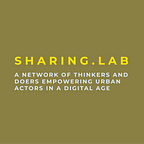Can apps bring us closer together?
On being hyperconnected, yet disconnected
We trust our homes and cars with strangers, collaborate online to map the surface of Mars, and turn our apartments into coworking spaces.
Recently, we’ve seen an increase in collaborative lifestyles, advanced digital technologies and social networks have made this possible. However, in spite of these widespread, social networks, we are lonelier than ever.
Hyperconnected, but alone
We have three main forms of expression, to convey our feelings, namely the spoken words, the tonality of our voice, and our facial expressions. Today, our devices and online personas have redefined our connection and communication, so how can we truly express ourselves if the majority of our interactions are digital?
Young people in the UK suffer from an “epidemic” of loneliness similar to the levels of isolation experienced by the elderly despite being more connected by technology, than any previous generation. We live in a hyperconnected world, yet we’ve forgotten what it means to be connected in the physical space.
‘Hyperconnectivity is the increasing digital interconnection of people — and things — anytime and anywhere. By 2020 there will be 50 billion networked devices. This level of connectivity will have profound social, political and economic consequences, and increasingly form part of our everyday lives.’
Only three years ago, Sherry Turkle asked us to ‘think deeply about the new kinds of connection we want to have’:
This seems now more relevant than ever.
Apps
Could an app connect us in the physical space, and be the solution to our disconnectedness? It sounds a bit odd, but there are many different apps trying to do exactly this, have a look here:
Somebody
Somebody calls itself ‘A Messaging Service’. When you send your friend a message through Somebody, it goes — not to your friend — but to the Somebody user nearest your friend. This person (likely a stranger) delivers the message verbally, acting as your stand-in.
Feel Me
Feel Me explores the space between syncronous (phone and video calls) and asyncronous (emails and texts) communications. It wants to create a sweet, playful connection with the person on the other side.
Umbrella Here
Umbrella Here wants to ‘bring strangers together on rainy days’ by giving people holding umbrellas the opportunity to invite others to join them.
Want to know more?
At Sharinglab we’re dedicated explorers of how to bring attention to the social aspect of the sharing economy. Now that it’s become a mega trend, we’re highly interested in how it can bring people closer together in real life.
If you’ve come across apps with similar aims, don’t hesitate to let us know. Also, feel free to comment, we’d love to hear your thoughts on the subject.
This post was originally posted at sharinglab.dk
